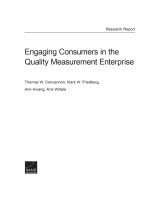| 来源类型 | Research Reports
|
| 规范类型 | 报告
|
| DOI | https://doi.org/10.7249/RR1760
|
| ISBN | 9780833097125
|
| 来源ID | RR-1760-COMCI
|
| Engaging Consumers in the Quality Measurement Enterprise |
| Thomas W. Concannon; Mark W. Friedberg; Ann Hwang; Kris Wiitala
|
| 发表日期 | 2017
|
| 出版年 | 2017
|
| 页码 | 43
|
| 语种 | 英语
|
| 结论 |
Six Barriers to Consumer Involvement in the Measure Development Process- Unequal Power: An inherent power differential exists between consumers, who have fewer available resources, and professionals, who are generally employed in the health care sector. Imbalances of power can be especially acute during technical stages of quality measurement, including creating measure concepts, specifying measures, and testing measures.
- Limited Menus: In some cases, invitations to participate in the quality measurement process are made to consumers after much of the early work has been completed. This approach leaves consumers out of some of the most important decisions that are made in quality measurement work — that is, what priorities to set, rather than which measures to use.
- Critical Mass: Quality measurement discussions often occur at stakeholder committees or expert panels that tap a handful of consumer advocates who are expected to represent a broad range of consumer experiences. The inherently diffuse nature of consumer representation argues for ensuring a critical mass of consumers.
- Flat Footed: Consumer and community input is sometimes solicited but consumer organizations do not always have adequate time to respond to requests for involvement.
- Closed Doors: Some parts of the quality measurement process may not currently involve consumers. Certain communications about quality measurement efforts happen through informal channels or parts of the process that are open to consumers in one state or location may be closed to consumers in another.
- Dual Focus: When participating in the quality measurement process, it can be a challenge to keep track of both the big picture and the details.
|
| 摘要 |
- Quality measurement leaders should: clarify the goals of quality measurement; affirm the importance of consumer-centeredness to their work; emphasize openness to new views; offer financial support to consumer participants; ensure adequate consumer representation; involve consumers early in the process; train consumers and offer technical assistance; develop tools to support ongoing consumer input; and assess and learn from experience.
- Consumer advocates should: focus national attention on consumer-centered quality measurement; assess the extent to which quality measurement processes are open or closed to consumers nationally; convene independent and public reviews of quality measurement work; and build and share knowledge and technical expertise about the process.
|
| 主题 | Health Care Delivery Approaches
; Health Care Program Evaluation
; Health Care Quality Measurement
; Patient Experience
|
| URL | https://www.rand.org/pubs/research_reports/RR1760.html
|
| 来源智库 | RAND Corporation (United States)
|
| 引用统计 |
|
| 资源类型 | 智库出版物
|
| 条目标识符 | http://119.78.100.153/handle/2XGU8XDN/108650
|
推荐引用方式
GB/T 7714 |
Thomas W. Concannon,Mark W. Friedberg,Ann Hwang,et al. Engaging Consumers in the Quality Measurement Enterprise. 2017.
|
|
文件名:
|
x1535046381000.jpg
|
|
格式:
|
JPEG
|

|
文件名:
|
RAND_RR1760.pdf
|
|
格式:
|
Adobe PDF
|
除非特别说明,本系统中所有内容都受版权保护,并保留所有权利。